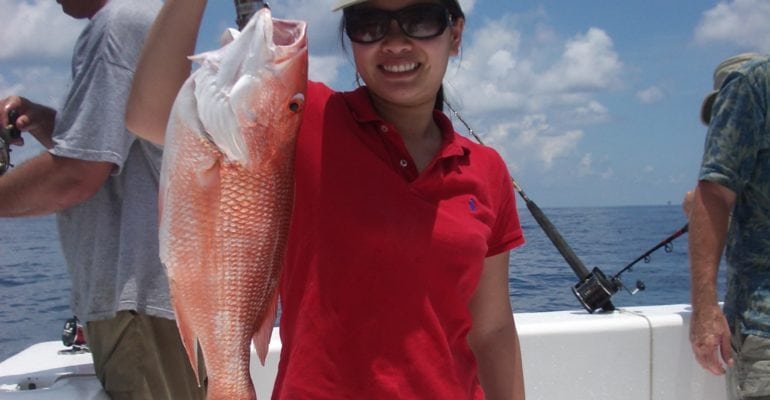KEY MESSAGE:
NOAA Fisheries announces a final rule to maintain a reduced buffer between the recreational for hire component annual catch limit (ACL) and recreational annual catch target (ACT) for Gulf of Mexico (Gulf) red snapper. The reduced buffer would result in an increased ACT, which determines the length of the federal for-hire fishing season.
WHEN RULE WILL TAKE EFFECT:
- The rule will be effective March 23, 2020.
WHAT THIS MEANS:
- The current ACL for the federal for-hire component is 3.130 million pounds.
- For 2019, the buffer between the ACL and the ACT was temporarily set at 9%.
- If this final rule were not implemented, the buffer between the federal for-hire ACL and ACT would be 20%, resulting in an ACT of 2.504 million pounds for 2020.
- The final rule continues the 9% buffer, resulting in an ACT of 2.848 million pounds.
- The ACT is used to estimate the federal for-hire component season length.
- These 344,000 extra pounds will likely add 7-8 days to the 2020 season.
- NOAA Fisheries will be announcing the 2020 federal for-hire component season soon.
FORMAL FEDERAL REGISTER NAME/NUMBER: 85 FR 9684, published February 20, 2020
This bulletin serves as a Small Entity Compliance Guide, complying with section 212 of the Small Business Regulatory Enforcement Fairness Act of 1996.
Frequently Asked Questions
Why is this change occurring?
- For the recreational sector, ACTs were developed to reduce the likelihood that the recreational sector as a whole or either component (federal for-hire or private) exceed their ACLs. The red snapper recreational federal for-hire fishing season is projected from the ACT.
- Because the federal for-hire component has never exceeded its ACT, with the exception of 2018, the Gulf of Mexico Fishery Management Council (Council) determined that the buffer between the ACL and ACT could be reduced from 20% to 9% in 2019.
- The rule continues the 9% buffer for the federal for-hire component.
What is a federal for-hire component and how does it differ from private angling component?
- The federal for-hire component is comprised of all for-hire operators with a valid or renewable federal reef fish charter vessel/headboat permit.
- The private angling component is comprised of private recreational anglers and other for-hire operators who do not have a federal reef fish charter vessel/headboat permit.
What is the difference between an annual catch limit and annual catch target?
- The annual catch limit (quota) is the amount of fish that can be harvested from the population each year.
- The annual catch target is a level of catch reduced from the annual catch limit to account for management uncertainty.
Why were the changes for the federal for-hire ACT originally proposed only for 2019?
- In 2018, all five Gulf states were issued exempted fishing permits (EFP) for a pilot study that allowed those states some management authority of the private angling component in state and federal waters through 2019.
- In 2018, the states were successful in keeping private angling component landings less than the private angling component ACL.
- The Council determined the federal for-hire component ACT could be increased as discussed above while the states managed the private angling component.
- Because the change in how the private angling component is being managed was to end after the 2019 fishing year, the federal for-hire component buffer between the ACL and ACT would return to 20% after 2019 to account for increased management uncertainty associated with recreational red snapper harvest projections.
Why did the Council decide the 9% ACL buffer for the federal for-hire ACT could continue after 2019?
- The Council recently submitted to NOAA Fisheries six amendments (Amendments 50A-50F) that would establish management of the private angling component by the Gulf states similar to the state management programs that were tested under the EFPs.
- Under the amendments, the private angling component ACL is apportioned between the states, the states would be required to establish a fishing season, and states would have to establish post-season accountability measures.
- Because state management of the private angling component is expected to continue after 2019, the Council determined the reduced buffer between the federal for-hire component ACL and ACT could continue.
Where can I find more information on the modifications to the red snapper federal for-hire component ACL and ACT?
- Contact NOAA Fisheries, Southeast Regional Office.
By Mail: Peter Hood
NOAA Fisheries, Southeast Regional Office
Sustainable Fisheries Division
263 13th Avenue South
St. Petersburg, Florida 33701-5505
By FAX: (727) 824-5308
By Phone: (727) 824-5305
- The framework action to modification to the federal for-hire red snapper ACT buffer may be found online at the NOAA Fisheries Southeast Regional Office Web site at: https://www.fisheries.noaa.gov/action/framework-action-fishery-management-plan-reef-fish-resources-gulf-mexico-modification.
- Information on the initial action setting the 9% buffer may be found at: https://www.fisheries.noaa.gov/action/framework-action-modification-gulf-mexico-red-snapper-and-west-florida-hogfish-annual-catch.
- Information on Reef Fish Amendments 50A-F may be found at: https://www.fisheries.noaa.gov/action/amendment-50a-f-state-management-program-recreational-red-snapper.
- Additional information on management of red snapper in the Gulf may be found at: https://www.fisheries.noaa.gov/management-plan/gulf-mexico-reef-fish-fishery-management-plan.





